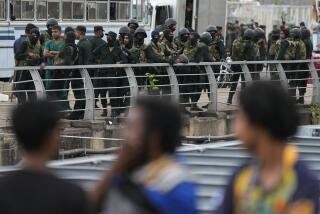THE TSUNAMI KILLED FEWER people in Sri...
- Share via
THE TSUNAMI KILLED FEWER people in Sri Lanka -- 31,000 -- than in Indonesia, but its damage to the island nation may prove more long-lasting. The disaster exposed the fragility of a cease-fire between the government and Tamil rebels fighting for independence for their portion of the country.
Squabbles over dividing the foreign aid that poured in after the tsunami increased the bad feelings on both sides. Former Prime Minister Mahinda Rajapaksa, in his successful November campaign for president, vowed to get tough on the Tamils, winning him support from strident Sinhalese nationalists. Tamil terrorists, already battling internal divisions, enforced an election boycott in territory they control.
On Wednesday, Rajapaksa met in New Delhi with Indian Prime Minister Manmohan Singh, with both governments urging a resumption of peace talks. That plea was echoed by Erik Solheim, the Norwegian official who brokered the 2002 cease-fire.
The wobbly truce was undermined in August by the assassination in his home of the foreign minister, a Tamil who had denounced the Tigers terrorist group. This month, more than 40 soldiers, sailors and police have been killed in renewed violence that the government blames on the Tigers. The rebels claim the 3 million Tamils need a homeland in the northeast separate from the 14 million Sinhalese.
As the country appears headed for a resumption of civil war, coastal dwellers whose homes were obliterated by the tsunami wait for help from the fumbling government.
Sri Lanka’s auditor-general reported in September that only 1,100 of the nearly 50,000 homes damaged in the tsunami had been repaired. He cited “waste and corruption,” including the payment of hundreds of thousands of dollars in relief to families in a coastal region not struck by the tsunami. Villagers have complained of the previous government’s ban on rebuilding within 100 yards of the shore, with fishermen saying proposed housing sites are too far from their boat docks. With most emergency food and basic health needs met, housing has become the main priority. Government officials initially promised to have 60% of permanent houses built within a year and 100% by 2007. In reality, less than 10% of the permanent houses are ready.
Rajapaksa’s government needs to meet the Tamil rebels for talks -- soon. It also needs to dispatch civil servants to devastated areas to coordinate distribution of money and materials so Sri Lankans -- be they Sinhalese or Tamil, Buddhist, Hindu or Muslim -- can resume their shattered lives.
More to Read
Sign up for Essential California
The most important California stories and recommendations in your inbox every morning.
You may occasionally receive promotional content from the Los Angeles Times.













